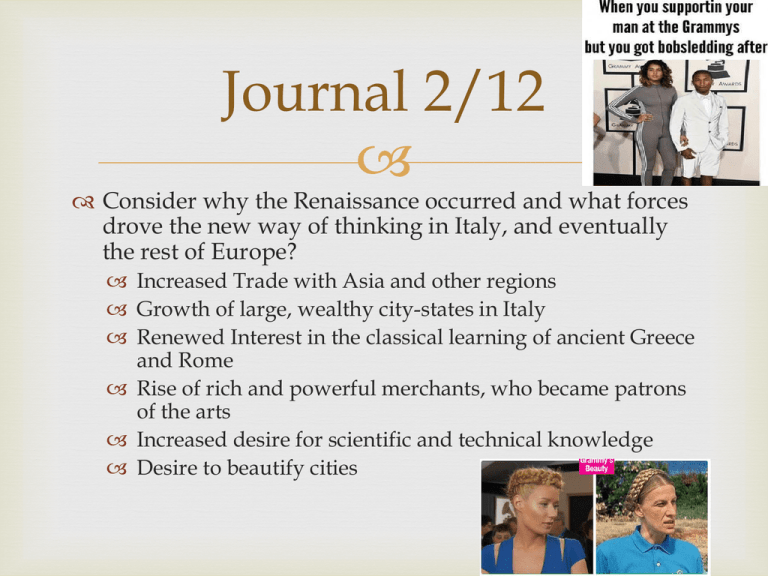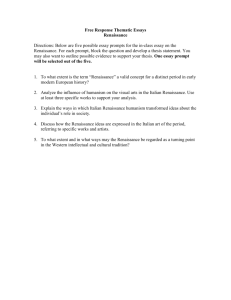Journal 2/11 - Cloudfront.net
advertisement

Journal 2/12 Consider why the Renaissance occurred and what forces drove the new way of thinking in Italy, and eventually the rest of Europe? Increased Trade with Asia and other regions Growth of large, wealthy city-states in Italy Renewed Interest in the classical learning of ancient Greece and Rome Rise of rich and powerful merchants, who became patrons of the arts Increased desire for scientific and technical knowledge Desire to beautify cities Vocabulary Chapter 15 – The Renaissance and Reformation Renaissance Humanists Perspective Johannes Gutenburg William Shakespeare Reformation Indulgences Martin Luther Sects Henry VIII John Calvin Theocracy Counter-Reformation Council of Trent Jesuits Broadsides Almanacs Standard of Living Objectives The beginning of the Renaissance (changes in society and the rise of city-states) Renaissance Ideas (Inspiration from the ancients, humanism, secular writing, and science) Renaissance Art Anticipation Write a diary entry for the time period (early 1300’s) by answering the following prompt: Imagine that you live in Florence, Italy immediately following the Black Death. You have survived, but many around you have not. Describe your environment. How do you feel? Black death = bubonic plague, a disease that spread from Asia along trade routes by way of fleas on rats that occupied the ships. Around 25 million (1/3 of the population died). People’s faith in God was shaken and the church lost a lot of its power and importance. Relations between upper and lower class changed. Workers in short demand now wanted higher wages and staged uprisings. Journal 2/20 Compare these works of art. What do you notice? Pietro Cavallini’s Birth of the Virgin Raphael’s School of Athens An Era of Awakening In the early 1300’s a movement began in Italy that began to altar how Europeans viewed themselves and the world. The Renaissance (“rebirth”): both a philosophical and artistic movement and the era when that movement flourished. Marked by renewed interest in ancient Greek and Roman literature and life. A new emphasis on the power of human reason developed, and many advances were made in the arts and sciences. Causes of the Italian Renaissance Natural for the Renaissance to begin in Italy Italian cities (Florence, Milan, Naples, Rome, and Venice) had grown rich through trade and industry. Their citizens included educated, wealthy merchants and bankers. Ruins of the Roman Empire, The Crusades, trade with southwest Asia & Africa (learned of Arab and African achievements in science and medicine) = encouraged curiosity and the search for new knowledge among some Italian thinkers. The Humanities The study of classical Greek and Roman literature to learn grammar, history, poetry, and rhetoric. People who specialize in these studies are humanists. Believed it was important to understand how things work and it led them to emphasize education. Francesco Petrarch One of the first humanists (1304-1374) Believed classical writers could best be imitated by studying their writings Wrote sonnets to Laura, considered some of the greatest love poems of all time. Niccolo Machiavelli A Florentine writer, diplomat, and historian. Sought to describe government the way in which it actually worked. (dog eat dog) Argued that a ruler should be concerned only with power and political success. Today some people refer to ruthless behavior to get ahead as “Machiavellian.” “A controversy has arisen about this: whether it is better to be loved than feared, or vice versa. My view is that it is desirable to be both loved and feared; but it is difficult to achieve both and if one of them has to be lacking, it is much safer to be feared than loved…. Men are less hesitant about offending or harming a ruler who makes himself less loved than one who inspires fear. For love is sustained by a bond of gratitude, which because men are excessively self-interested, is broken whenever they see a chance to benefit themselves. But fear is sustained by a dread of punishment that is always effective.” Considered a humanist because he looked to ancient Romans as models, but his lack of concern for conventional morality was considerably different than other humanists of this time. Italian Renaissance Art Start to see more realistic scenes and images that depict lifelike human figures. Earlier artists often portrayed the Holy Land, while Renaissance painters showed the rugged Italian countryside they knew so well. Began to use a technique called perspective to make their paintings more lifelike. Made distant objects smaller than those in the foreground of the painting. Created the illusion of depth on a flat canvas. Giotto Used light and shadows to create a powerful sense of depth in his paintings. Lamentation (The Morning of Christ) Leonardo da Vinci The Last Supper Michelangelo Frescoes in the Sistine Chapel of the Vatican http://www.history.com/topics/italian-renaissance Journal 2/23 Have you read or seen any of Shakespeare’s plays? If so, which ones? Have you seen any movies that are portrayals of his stories? Date/Copy/Answer The Northern Renaissance Chapter 15 Section 2 The Spread of Ideas Geography: Ideas and messages were able to pass through passageways of the Alps in Northern Italy. Danube, Rhine, and Rhone Rivers = easy routes for ideas to spread. Printing Press: Johannes Gutenberg – printed copies of the Bible Books spread humanist ideas to a larger audience Writers of the Northern Renaissance The most influential humanist of northern Europe, Desiderius Erasmus Interested in early Christian period as well as early Greek and Roman culture Criticized lack of spirituality in the Church Thomas More An English humanist and friend of Erasmus Published Utopia – criticized corrupt government and wrote about an ideal society where all male citizens were equal. Quote from Utopia “…wherever you are, you always have to work. There’s never any excuse for idleness… Everyone has his eye on you, so you’re practically forced to get on with your job, and make some proper use of your spare time. Under such a system, there’s bound to be plenty of everything, and, as everything is divided equally among the entire population, there obviously can’t be any poor people or beggars.” Became very popular and translated to many European languages. William Shakespeare Built on the traditions established by Christopher Marlowe & other playwrights. Focusing on human, rather than godly, actions. Transforms well-known stories into dramatic masterpieces. Portrays personality and human emotions. Hamlet, Romeo and Juliet, Macbeth Artists of the Northern Renaissance Built on the skill of the Italian painters and artists. Flemish school: painters from Flanders that developed and perfected certain techniques of painting in oil on canvas. Jan and Hubert van Eyck (The Flemish Brothers): paid great attention to detail and used facial expressions in their work. Pieter Brueghel the Elder painted in the mid 1500’s Loved to paint the countryside and peasants of his native Flanders. The Blind Leading the Blind Albrecht Durer, a German artist, was famous for his copper engravings and woodcuts. Saw the possibilities of printed illustrations in books. Hans Holbein the Younger traveled through Europe painting portraits of famous people. Erasmus, Thomas More, King Henry VIII Reflects the Renaissance interest in the individual Portrait of Henry VIII Renaissance Report You and a partner will be writing a report on one Italian Renaissance writer and one artist; along with one northern Renaissance writer and one artist. (4 people total) Your report will need to include: Their name Background information Their styles/developments Origin, Date of Birth/Death, Education, Family, interesting facts, other Occupations, etc… Were they humanists? What they are famous/remembered for Any famous work Pictures Sources used Must use credible/reliable sources (2 for each report) No wikipedia, .com, or infoplease I will be checking your sources if I suspect plagiarism, so if I cannot find yours it will not count! Due at the end of the next class period!!!!! (will have some time to finish up) (February 25th) No late work will be accepted Quiz Grade William Shakespeare William Shakespeare was born April 23, 1564 in Stratford-on-Avon, a local government district in England. He attended school at King Edward IV Grammar School in his hometown where he learned Latin and some Greek. He also studied the classics which later influenced his writing (humanist). At the young age of 18, he married a girl named Anne Hathaway and they had three children. Two daughters, Susanna and Judith. Judith had a twin brother that died at a very young age. He started out at an apprenticeship to be an actor. He then developed into a playwright and actor. In 1594 he joined the Lord Chamberlain’s company of actors and then in 1599 joined the Chamberlain’s Men where they built and operated the Globe (one of the most famous theaters of its time). Shakespeare is known for his great playwrights, but he looked to poetry for enduring fame. He wrote many sonnets, including 154 in the Sonnets of Shakespeare, that almost all show the inevitable decay of time and the immortalization of beauty and love. Within his poems and plays he invented thousands of words that often combine Latin, French, and native roots. According to the Oxford English Dictionary, he is credited with such words as arch-villain, birthplace, bloodsucking, courtship, dewdrop, downstairs, leapfrog, watchdog, and many more. He wrote more than 30 plays that can be placed into four categories including histories, comedies, tragedies, and romances. In his early playwright years they were mostly comedies or histories like the Comedy of Errors and Henry VI. Then he turned to tragedies like Romeo and Juliet. Then in his late years he turned to romance like A Winter’s Tale and The Tempest. Only 18 of his plays were published during his lifetime. It was sometime after 1612 that he decided to retire and return to his home in Stratford. He then died on April 23, 1616. Sources http://www.poets.org/poetsorg/poet/williamshakespeare http://www.shakespeareinamericancommunities.or g/education/life-william-shakespeare William Shakespeare A modern portrayal of Romeo and Juliet



